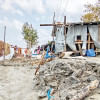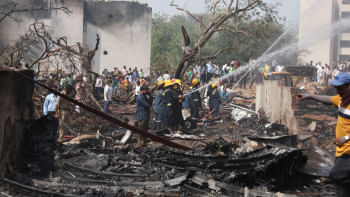How to beat the heat? Live in adobe homes or become a troglodyte

The summer of 2023 was marked by record-shattering heatwaves with widespread local extremes that made daily life for the vast majority miserable beyond measure. July temperatures in large parts of southern Europe were so high – over 40 degrees Celsius – that the Italian Meteorological Society dubbed the heatwave as the "Cerberus Heatwave," after the fearsome three-headed dog of Greek mythology. The sobriquet may seem peculiar, but it should not detract us from the danger posed by the blistering heatwaves.
Thanks to climate change, in the middle of winter in the Southern Hemisphere, towns in the Andes mountains reached 38 degrees for a few days in August, while Buenos Aires saw temperatures above 30 degrees. Wildfires are spreading everywhere, killing hundreds and forcing thousands to flee from their homes. People in Maui (Hawaii) jumped into the ocean to escape "apocalyptic" wildfires. And ocean waves near California have grown a foot higher.
These and other extreme weather events are vociferously announcing that the Earth is racing towards the dreaded climate "tipping points" – conditions beyond which changes become self-perpetuating and irreversible. Accordingly, to underscore the existential threat we are facing today, UN Secretary General António Guterres warned that "the era of global warming has ended" and the "era of global boiling has arrived." By contrast, conservatives in the US House of Representatives are laying the groundwork for a 2024 Republican administration that would dismantle efforts to slow global warming.
Notwithstanding the insouciance of the ultra-right lawmakers in the US and elsewhere, how can ordinary folks survive in the new era in which heatwaves are predicted to be longer-lasting, more frequent and brutally hot? Out of many cooling possibilities, one option is to live in homes that are built with adobe blocks, similar to the traditional mud houses in Bangladesh. Another, albeit far-fetched but practised in several countries, is to become a cave dweller, also known as troglodyte.
The summer temperatures in the high desert regions of the United States, like Mojave, Barstow, Phoenix and Las Vegas, are consistently over 40 degrees. To cope with such high temperatures, the building material for most of the homes in the American southwest are adobe blocks, which are a mixture of clay, sand, straw and water dried in the hot summer sun.
Before entering the cave, we were expecting to see a home from the Stone Age – dirty, dank, poorly lit rooms with primitive toilets and kitchens. After the proud owner of the cave beckoned us to follow him into his home, we were taken aback at what we saw: electric lights, ducts for air circulation, modern bathrooms with showers, toilet bowls, running hot and cold water, and a state-of-the-art kitchen.
Due to its earthen makeup, the adobe walls absorb heat during the day and radiate it at night. During winter, the walls hold the heat and keep the cold outside. Unique as they are, adobe homes are more fire-resistant and help reduce energy consumption. If properly constructed, they can last for a long time without requiring significant repairs. Moreover, unlike regular bricks, making adobe bricks is eco-friendly as they do not require a kiln, and thus do not emit planet-warming greenhouse gases.
On the other hand, to deal with challenging climates, people have been living in caves for thousands of years. Storage of geothermal energy keeps the caves comfortable throughout the year. For example, from about 1190 to 1300, the ancient Native American Anasazi built shallow caves under the overhanging cliffs along the walls of the canyon of Mesa Verde – Spanish for "green table mountain" – near Cortez in Southwestern Colorado.
Known as the Kingdom of Caves, up to 20,000 people in Cappadocia in central Turkiye lived in underground cities from the seventh century up until 1952. Now, many cave dwellings have been restored into upscale hotels.
There are cave dwellers today too. Recently, as my wife and I were travelling from Granada to Valencia in Spain, we stopped at an off-the-beaten-path provincial town of Gaudix to see a cave dwelling. The cave area is signposted as "Barrio Troglodyte," which means "town of cave dwellers." Lodged into the ochre-coloured cliffs of the surrounding area, cave dwellings in the region, where many of the residents have been living for hundreds of years, were hollowed out of the soft tufa stone of the hills. The dazzling whitewashed chimneys and walls of the caves juxtaposed dramatically with the snow-covered peaks of the nearby Sierra Nevada Mountain Range.

Before entering the cave, we were expecting to see a home from the Stone Age – dirty, dank, poorly lit rooms with primitive toilets and kitchens. After the proud owner of the cave beckoned us to follow him into his home, we were taken aback at what we saw: electric lights, ducts for air circulation, modern bathrooms with showers, toilet bowls, running hot and cold water, and a state-of-the-art kitchen. Clearly, the underground home of our host had all the amenities of the 21st century, including Wi-Fi and other cutting-edge technologies.
Inside the cave dwellings in Gaudix, the temperature is around 18-20 degrees day and night, all year round. Outside temperature was 10 degrees during our visit in December. The troglodytes at Guadix, therefore, do not need cooling or heating devices.
Troglodytes can be found in many other regions of the world. In Coober Pedy, an opal-mining town in the Australian outback where summer temperatures regularly hit 52 degrees, roughly 60 percent of the population of well-nigh 2,500 are troglodytes. In addition to homes, there are subterranean restaurants, shops, motels and a church.
In certain areas of northern China, caves serve as homes for more than 40 million people. Some of the local Berbers in Matmata, a village in southern Tunisia, live in underground caves. There are troglodytes in Bamiyan in central Afghanistan, Sassi di Matera in southern Italy, and the Bandiagara Escarpment, a sandstone cliff in Mali. In the Loire Valley and Dordogne region in France, there are caves inhabited by troglodytes. People of Bhalil village in Morocco live in caves carved from the rock face.
There has never been a "one silver bullet"-type solution for dealing with intense heatwaves. Yet, when push comes to shove, we have to rethink the structure of our life in the context of an entire ecosystem and make suitable changes to the way we are living today. If our leaders are reluctant to tackle the root cause of global warming, then one such change is returning to a simpler lifestyle – build thermally insulated homes with adobe bricks or become a troglodyte.
Dr Quamrul Haider is professor emeritus at Fordham University in New York, US.
Views expressed in this article are the author's own.
Follow The Daily Star Opinion on Facebook for the latest opinions, commentaries and analyses by experts and professionals. To contribute your article or letter to The Daily Star Opinion, see our guidelines for submission.

 For all latest news, follow The Daily Star's Google News channel.
For all latest news, follow The Daily Star's Google News channel. 










Comments